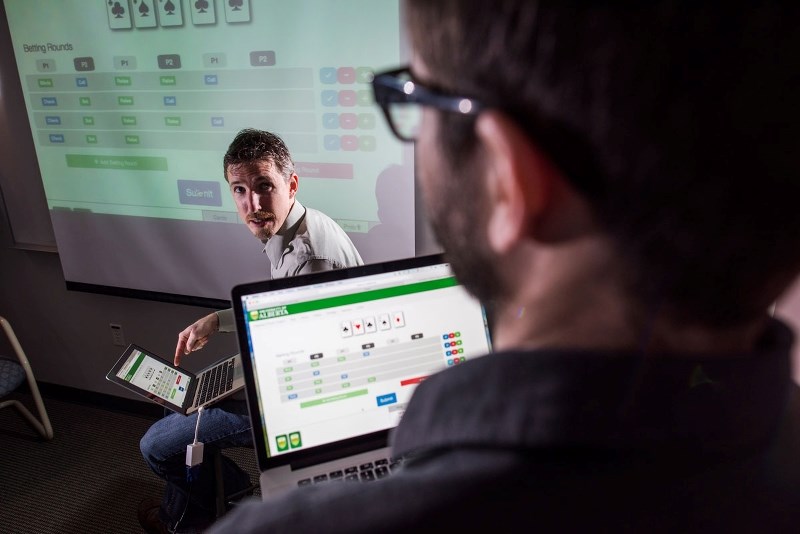The robopocalypse took another step forward this week as U of A researchers unveiled an A.I. that could be unbeatable when it comes to poker.
A team of researchers led by University of Alberta computing science professor Michael Bowling published a study in Science this week on how they made a computer program that can play a theoretically perfect game of heads-up limit hold ’em poker – a specific variant of Texas hold ’em poker with two players (heads-up), fixed bet sizes, and a set number of raises (limit).
Games are commonly used in artificial intelligence research, as they are essentially problems with defined rules, said Neil Burch, PhD student and a co-author of the study.
Games are considered “solved” in computer research when a program can win it all the time. While researchers have previously solved games such as chess, ones with hidden or random information such as poker had proven intractable.
“Poker is a really good example of the kind of game we’re trying to solve,” Burch said. Just like most real-world problems, it represents a situation where you have to take action while some information – your opponent’s hand, in this case – is unknown.
Bowling and his team created a poker program dubbed Cepheus (after a specific constellation) that could hash out a winning strategy by playing against itself.
Cepheus used a network of 200 computers to consider 10^20 hands of poker over about 69 days. As it played poker against itself, it gradually figured out which moves were most likely to let it win.
The end result was a massive 11-terabyte matrix of plays that, when followed, allows Cepheus to theoretically never lose a game – theoretically, since it hasn’t played an infinite number of games yet.
The team thinks it has “essentially solved” this game, as a player using Cepheus’s strategy would never lose even if they played 200 hands of poker an hour, 12 hours a day, every day for 70 years, Burch said.
“Our program basically doesn’t make mistakes,” he said.
“No matter how good the human player is, no matter how good its opponent is, it would probably beat them.”
While this could arguably make Cepheus the best poker player in the world, Burch said it’s unlikely to hit the tables at Vegas anytime soon due to its size. Human players are also better at exploiting mistakes than Cepheus, and thus win more money at poker.
Burch said this program could now be used to simulate other imperfect information problems, such as coast guard patrols.
Residents can play against Cepheus at poker.srv.ualberta.ca.
Struggling to lose weight as part of your new year’s resolution? The problem might lie in your grocery list, suggests a recent study.
Food sciences professor Lizzy Pope at the University of Vermont published a study last month in the online journal PLOS ONE on how the holiday season affects our food purchase habits well into the new year.
The study came out of a larger study on using price incentives to get people to buy healthy food, said study co-author Drew Hanks, a consumer economics professor at Ohio State University. It tracked the purchases of some 207 families in upstate New York at two grocery stores from July 2010 to March 2011.
The team noticed that the families tended to buy more unhealthy foods during the U.S. Thanksgiving-New Year’s period than they did in the pre-holiday July-November period – no surprise, as the holidays are associated with yummy treats, Hanks said.
“What we found intriguing was that the patterns persisted into the new year.”
Families spent about $16.09 more per week on food during the holiday period than they did in pre-holiday period, about $12.11 of which went towards less healthy stuff.
After the holidays, they spent even more – about $25.01 more per week on food compared to pre-holidays, equivalent to about 890 more calories per serving. What’s more, they continued to spend about the same amount ($11.77 more) on unhealthy food as before and piled more healthy food ($13.24 more) on top.
“Of course this has potential implications for obesity,” Hanks said.
“If these buying patterns persist throughout the year, waistlines will expand.”
Hanks said the team didn’t track buying patterns past March, so they’re not sure if the pattern resets later in the year. He suspects that consumers may be experiencing a “health halo” effect, in that they think they are eating better when they buying healthier food (whereas they are really just eating more).
Even though many families make new year’s resolutions to eat better or lose weight, their purchasing patterns are only partially supporting those goals, the study found.
Having unhealthy foods in the house is a major obstacle for new year’s weight loss, Hanks said. He recommends using a shopping list to cut down on unhealthy food purchases.
“I believe a key component to making lasting resolutions is not relying solely on willpower to achieve them,” Hanks said. Instead, we should use our surroundings to encourage behaviours consistent with those goals.
“By doing this, we have taken an important step to becoming slim by design.”
The study can be found at www.plosone.org.




